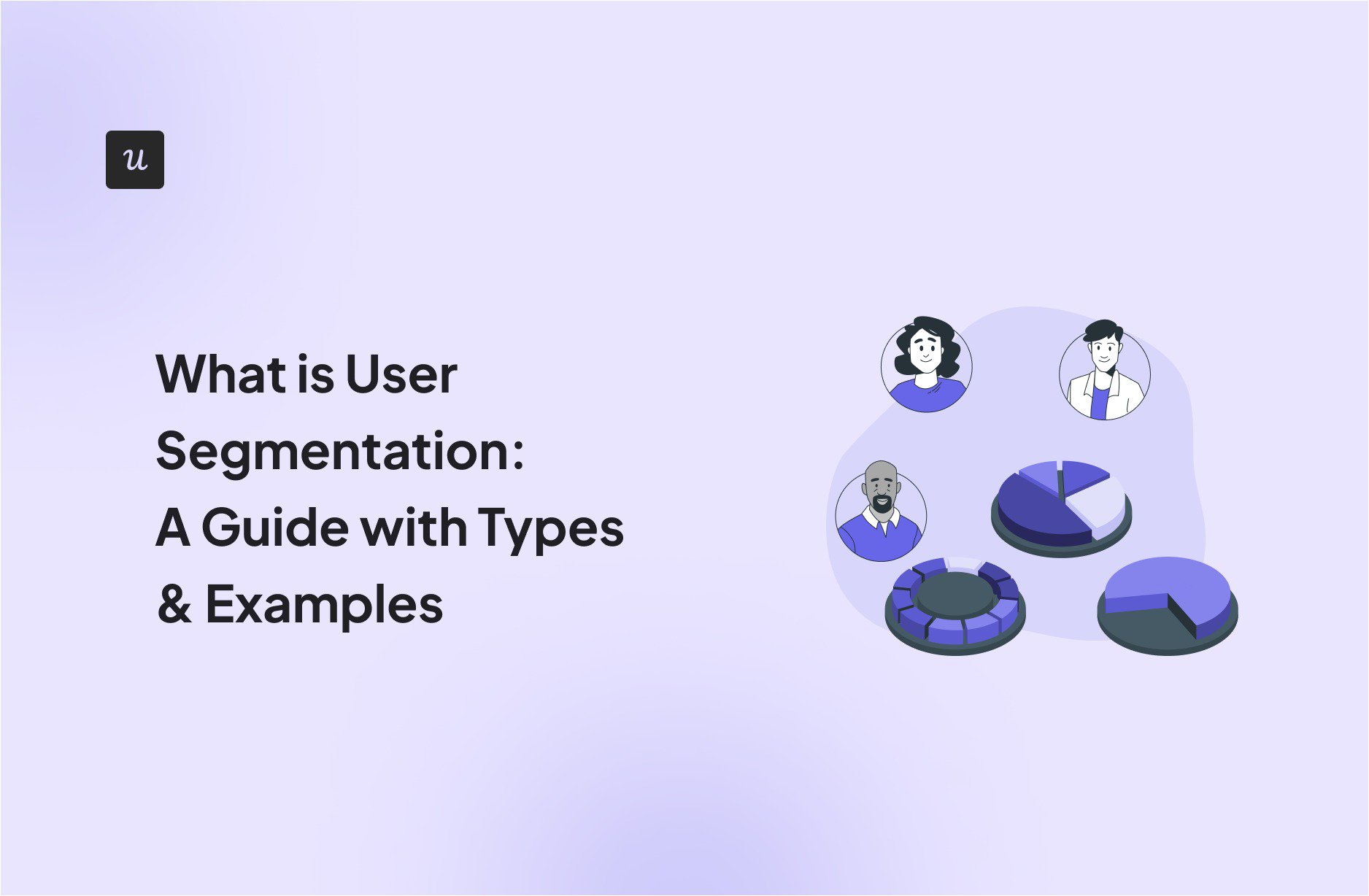
User segmentation is vital for building relevant and engaging experiences across all touchpoints in the user journey.
In the article, we explore different types of user segmentation, explain how to design a user segmentation strategy, and how to leverage segmentation to enhance user engagement.
Let’s get right to it, shall we?
Try Userpilot Now
See Why 1,000+ Teams Choose Userpilot

What is user segmentation?
User segmentation is the process of grouping users based on shared characteristics, like demographic properties or behavior.
Thanks to segmentation, teams can extract meaningful insights from user behavior data, design personalized experiences for users, and target them with relevant messaging.
Why does user segmentation matter?
There are two main reasons why user segmentation is non-optional.
Firstly, it allows you to make valid conclusions from user behavior analysis.
Think about it:
Your user base isn’t homogenous. For example, users have different goals or use the product on different devices. Consequently, their behavior patterns vary. Analyzing product usage without taking it into account would skew the results.
It doesn’t stop there.
By comparing the behavior of different user segments, you can find ways to improve the user experience. For example, you could compare the behavior or your power users and churned users with the same use case.
Secondly, user segmentation enables SaaS organizations to make the customer experience more relevant for their users.
For example, users with different goals will need different features to accomplish them, and the onboarding process should reflect this. Thanks to segmentation, you can trigger onboarding flows tailored to different use cases.
Different types of user segmentation
Modern analytics tools allow you to segment your users based on various characteristics.
Here are a few segmentation types commonly used by SaaS teams.
User segmentation based on customer data
This type of user segmentation uses customer data that you’d normally find in your CRM, like their pricing plan type, sign-up date, or spending history.
Such segmentation can help marketing and sales teams retain customers and drive account expansion through upsells or cross-sells.
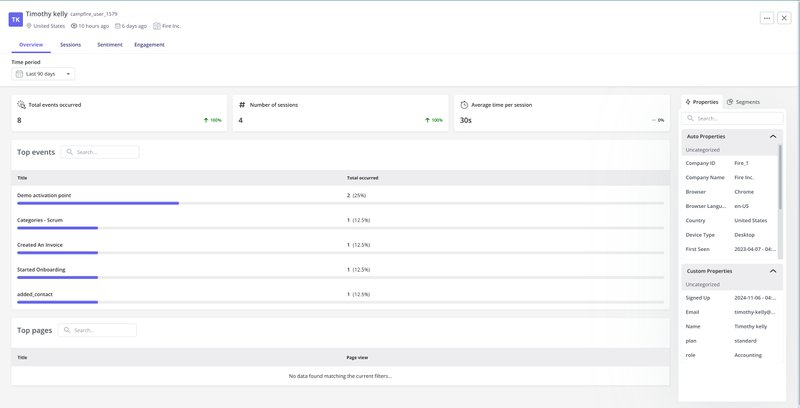
Demographic segmentation
Demographic segmentation is not just about geographic segmentation.
It groups users based on their personal and population characteristics, like age, gender, education, language, geographic location, or family background.
This kind of segmentation is useful for analyzing your target audience and tailoring your marketing efforts. You can also use it to localize user experiences.
Firmographic segmentation
Firmographic segmentation uses information about users’ companies. For example, you could segment users based on their industry, company size, maturity, location, or financial details, like revenue.
Behavioral segmentation
In behavioral segmentation, you create segments based on their product usage. That’s all the things they do inside the product – or don’t.
For example, you could segment users based on whether they use a feature, when they perform specific actions, or how long it takes them to complete tasks.
Psychographic segmentation
Psychographic segmentation uses information about shared psychological traits. It’s not about their objective properties but rather what they believe: their values, opinions, interests, and lifestyle choices.
SaaS companies can use this kind of segmentation to diversify their product lines and tailor marketing campaigns to attract the right customer base.
How to create a customer segmentation strategy
Ready to create your user segmentation strategy? Here’s our 6-step guide to the process.
Step 1: Create user personas
The process starts with defining the main user personas, or fictional representatives of the main user groups. For example, Userpilot’s personas include the product manager and the product marketing manager.
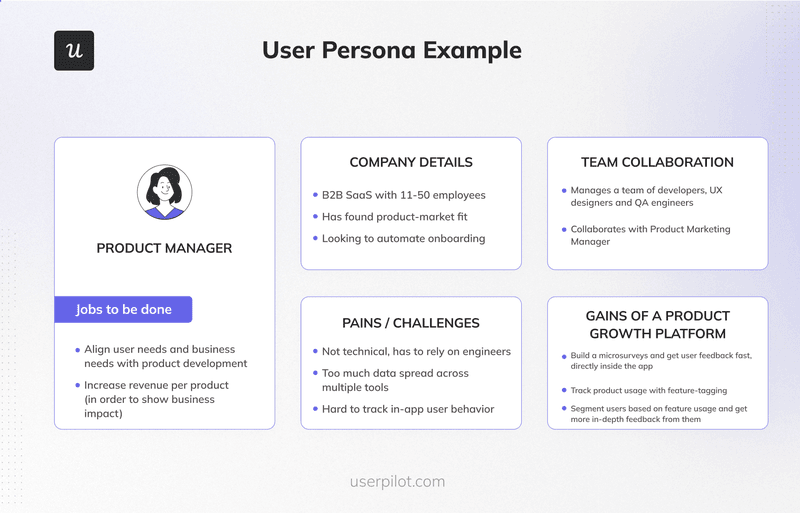
What information do you need to collect about them?
Make sure you know their:
- Role (e.g. product manager).
- Company details (e.g. B2B SaaS, 50-100 employees, product-market fit, focusing on onboarding automation).
- Key stakeholders within their organization (e.g. developers, UX designers).
- Jobs to be done (e.g. increase revenue).
- Pain points (e.g. struggling to capture relevant in-app behavior data).
- Benefits of using your product (e.g. can track product usage without coding).
Step 2: Collect customer data
With user personas in place, it’s time to collect user data for segmentation.
This is easy to do with welcome surveys when they first log into the product.
There’s a misconception based on B2C experiences that welcome surveys add friction to the user journey and should be kept to a minimum.
In B2B, this is true only to a certain extent. Irrelevant questions can discourage business users from carrying on, but they’re usually happy to answer questions that help you deliver a better customer experience.
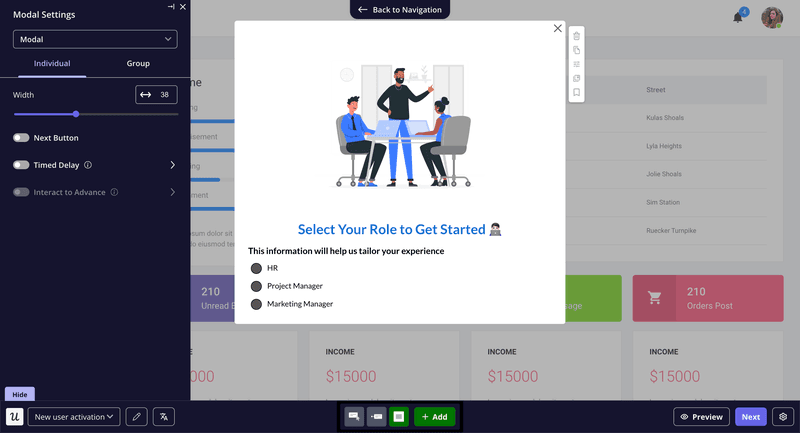
Step 3: Decide on your segmentation model
The next step is choosing the segmentation model. This depends on your goals.
For example, if your goal is improving customer satisfaction, you might use psychographic segmentation and group your users based on their NPS or CSAT survey responses. In this way, you can analyze differences in product usage and target them with experiences designed to address their pain points.
The reality in most SaaS companies is that teams try to move lots of needles at the same time, so you’re very likely to use all of the models above in parallel.
Step 4: Track user behavior among different user segments
Having chosen the customer segmentation model and assigned users to different segments, you’ve got to collect and analyze the relevant data.
Most of the time, however, you may already have the relevant data because you’re already tracking feature usage or specific events. All that is left is to visualize in reports or dashboards and filter the data for specific segments.
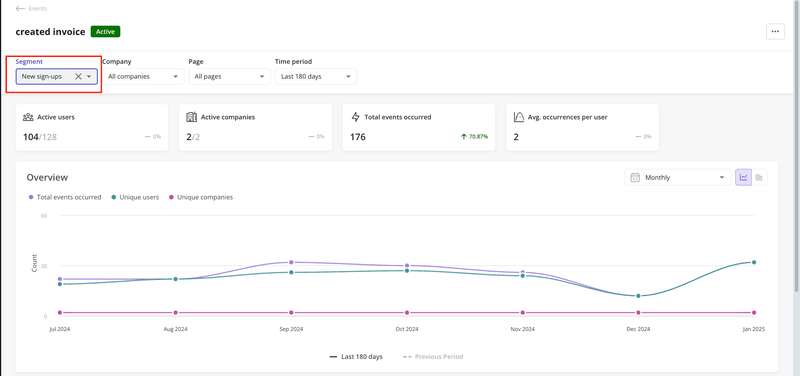
Still looking for a user behavior analytics tool? Find a platform where you can tag features and events without touching code. Or better yet, get one that tracks it all automatically, like Userpilot.
Step 5: Create strategies for different user segments
As you have analyzed the behavior of your user segments, use the insights to work out how to improve the metrics you’re targeting.
It’s hard to make general recommendations on how to do it because it depends on the findings and your goals.
For example, suppose your goal is to improve user satisfaction and you discover that the dissatisfied users underutilize a feature that’s very relevant to their use case. In that case, you can design in-app patterns to drive feature discovery and adoption.

Or if you realize that it’s mostly mobile users that tend to be less satisfied, your focus should be on optimizing the mobile experience.
Step 6: Measure the impact of those strategies
As you implement the changes, monitor their impact on the key metrics, and iterate until they move the needle in the right direction.
You can do it by visualizing the metrics in a graph and tracking trends over time. If there are multiple metrics to track, create dashboards where you can view all the data between switching views.
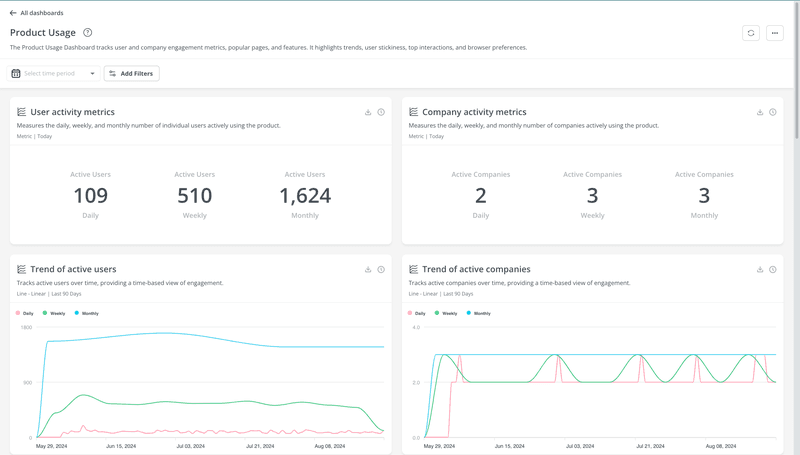
User segmentation examples to improve customer retention
In the previous section, I gave you an example of how you can use user segmentation to drive product results.
Let’s look at 7 more instances of user segmentation applications aimed at improving retention.
Segment new users to personalize customer experience
Imagine logging into the product for the first time and being flooded with information about all the product features and processes, most of them irrelevant.
How would you feel? For me, it would be extremely overwhelming and make me wonder if I’ve chosen the right product.
To avoid overwhelming users and reduce the time they need to reach value, use segmentation to personalize their experiences.
Here’s how:
For each user persona, design a bespoke onboarding flow focusing on the core features they need to accomplish their objectives.
Unsure of the quickest route to value for each customer segment? Use path analysis to see what your successful users are doing. Then, you can build guidance to lead new users down the same path.
When new users sign in, trigger a survey to segment them and use their responses to launch the right interactive walkthrough or onboarding checklist.
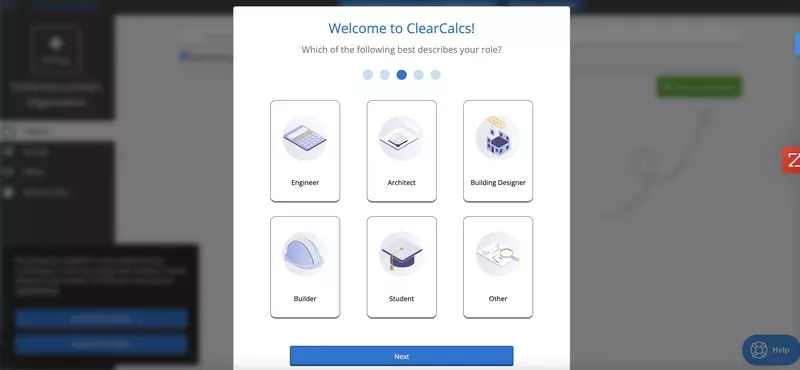
Create user segments based on the stage in the customer journey
How you engage your users depends not only on their JTBDs but also the stage in the user journey.
For example, for newly acquired users on the free plan, your priority is to activate them and convert them into paying customers.
To segment users based on their user journey stage, define the milestones that they need to reach to progress to the next stage, like signing up for the product or converting to a paid plan.
Next, use your product analytics tool to track the events. With Userpilot, these events are most likely to be tracked automatically with our auto-capture feature. Whenever you need them for segmentation or analytics, you only need to label them with our no-code visual labeler.
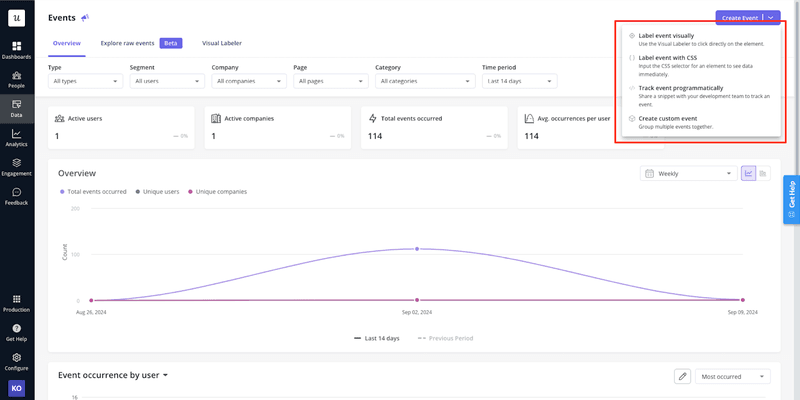
Segment active users for the secondary onboarding process
Once the user experiences the product value and adopts the key features, they’re ready for secondary onboarding. That’s when they discover more advanced functionality that enables them to realize the full product potential.
How do you know they’re ready?
Again, use your analytics tool. Set up a custom event made up of the actions needed to activate, like sending 10 messages, and segment all users who complete the event.
As soon as this happens, start targeting them with onboarding flows focusing on more complex features.
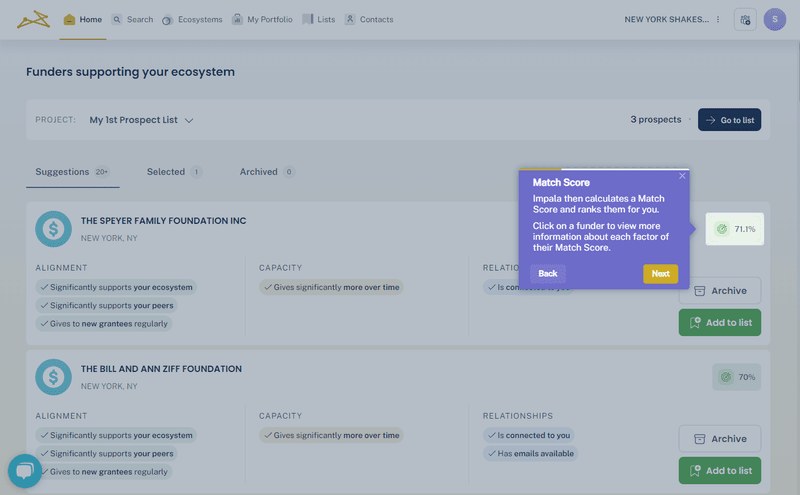
Segment disengaged users to improve user engagement
Disengaged users are one of the key user segments because they have a massive impact on product success. If a user doesn’t engage with the product regularly, they’re likely to churn.
That’s why it’s good practice to segment such users and target them with communications to bring them back to life.
If a user doesn’t engage with a single feature only, it’s easy to give them a nudge with an in-app message.
However, this won’t work with inactive users. To reach them, try push notifications (if they opted in to receive them) and emails.
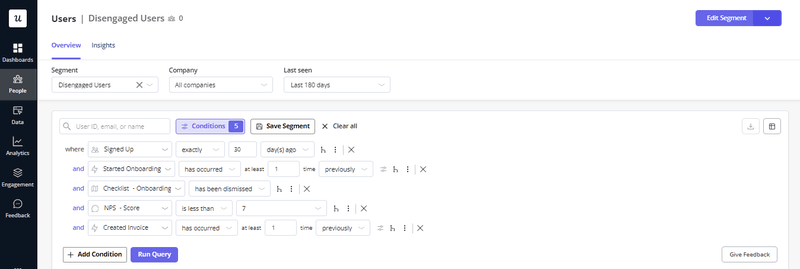
Segment power users for WoM marketing campaigns
Power users are the most successful and loyal customers. They make excellent product advocates because they know the product well, can use it competently to derive value, and are highly satisfied.
How do you know someone is a power user?
Again, depends on the product. For example, it may be the users who have been paying customers for a certain period, have adopted certain advanced features, or use the product frequently enough.
To harness their loyalty for WOM, consider inviting them to a referral scheme in which they get rewarded for recommending your product, an affiliate program, or making them product ambassadors.
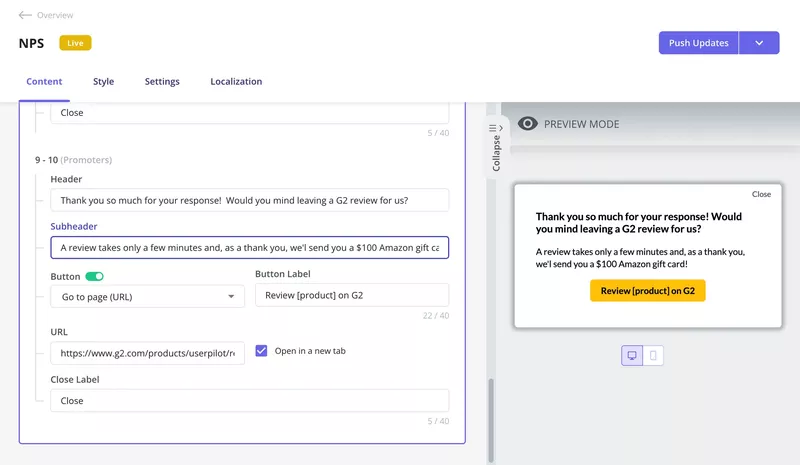
Segment customers to contextually prompt upsells
This is another example of segmentation based on the stage in the user journey and it builds upon secondary onboarding.
If your SaaS is like most others, you have a tiered pricing system, with certain features available only in the higher plans. You may also offer features as add-ons.
The goal of such a pricing model is to maximize customer lifetime value.
The catch is that account expansion efforts don’t work if the features aren’t important for the user.
What’s more, you can’t push users to upgrade to a higher plan after they log in for the first time. They first need to discover what the product has to offer and adopt the features in the free plan.
Only then can you start targeting them with upsell and cross-sell messages. They could be triggered contextually, for example, when the user completes an event that indicates they’re ready.
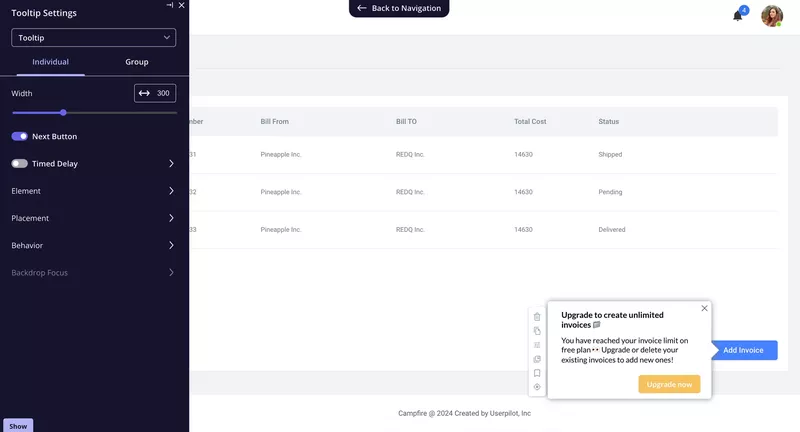
Segment users for early feature announcement
Before you roll out your features to the entire user base, you may want to consider a dark launch or beta test to assess its performance in real life.
Which users should you choose for the beta test?
Firstly, the new functionality needs to be relevant to their use case. Secondly, they must be a representative sample of the user population. Thirdly, they must be willing to test your product and, ideally, provide feedback.
To find users who meet the last criteria, you can segment them by the time to adoption and survey response rates.
Once your segment is ready, use toggles to enable the feature to them and send them in-app messages inviting them to take part in the test.
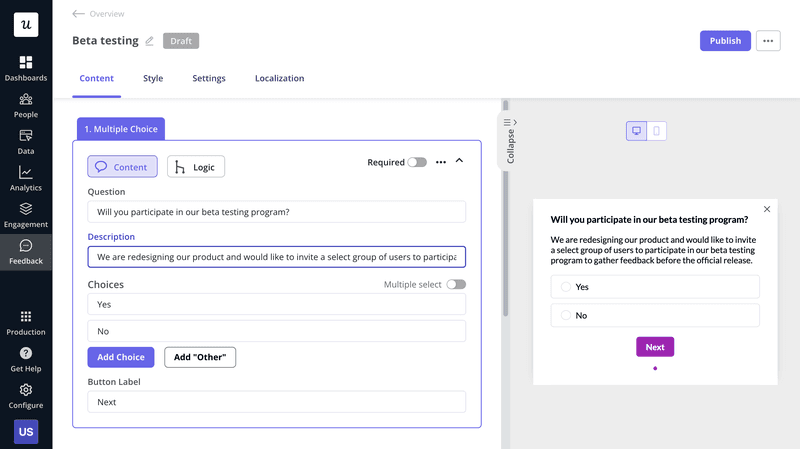
Conclusion
The ability to group users based on shared properties or behaviors is essential for customer success. It allows teams to better understand their user needs and tailor their experience to satisfy them.
If you’d like to learn more about segmentation in Userpilot and how you can leverage it to engage users and advance your product goals, book the demo!








